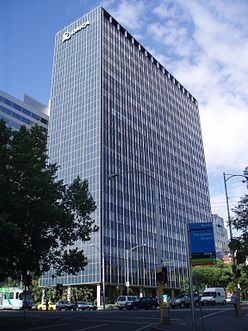- ICI House
-
ICI House 
ICI HouseGeneral information Architectural style International style Town or city Melbourne Country Australia Coordinates 37°48′32″S 144°58′24″E / 37.809°S 144.97344°ECoordinates: 37°48′32″S 144°58′24″E / 37.809°S 144.97344°E Construction started 1955 Completed 1958 Technical details Structural system 81 meters, 20 floors Design and construction Client Imperial Chemical Industries of Australia and New Zealand Architect Bates Smart McCutcheon ICI House (now Orica House) is a 20-storey office building in East Melbourne, Victoria, Australia. It was the tallest building in Australia upon completion in 1958, and the first to break Melbourne's long standing height limit.[1] It was one of the earliest fully glazed commercial skyscrapers in Australia. The move from low to high-rise office buildings changed the profile, shape and landscape of Australia's major urban centres forever. It symbolised progress, modernity, efficiency and corporate power in postwar Melbourne and was being constructed at the time of the 1956 Melbourne Olympics when the city was being showcased on the world stage.
ICI House was at the forefront of the high-rise boom in Australia's cities in the second half of the Twentieth Century. The building's design, by Sir Osborne McCutcheon (of Bates Smart McCutcheon) followed the international trend for multi-storey buildings which was being pioneered in the United States with the United Nations headquarters.
Built between 1955 and 1958 ICI Building was one of 22 major new multi-storey office buildings which sprang up in Melbourne in the second half of the 1950s. Its 19 storeys broke through the previous legal limit of 11 to 12 storeys, resulting in Melbourne becoming the first Australian city to change its height limits.
In earlier times, most Australian office buildings occupied their entire blocks. However, Plot ratio urban planning resulted in the modern free-standing high-rise and its surrounding landscaped gardens and car park introduced the idea of creating a balance between a building's height and public amenities.
The building made headlines for many years after initial construction as panes of glass frequently fell to the street below.[2]
It is one of the few post-war office buildings to be found on the Victorian Heritage Register.
References
- ^ Australian National Heritage listing for the ICI Building
- ^ When the price is too good article from The AGE
Categories:- Buildings and structures in Melbourne
- Heritage listed buildings in Melbourne
- Buildings and structures completed in 1958
- Australian National Heritage List
- Modernist architecture in Australia
- International style buildings
Wikimedia Foundation. 2010.
